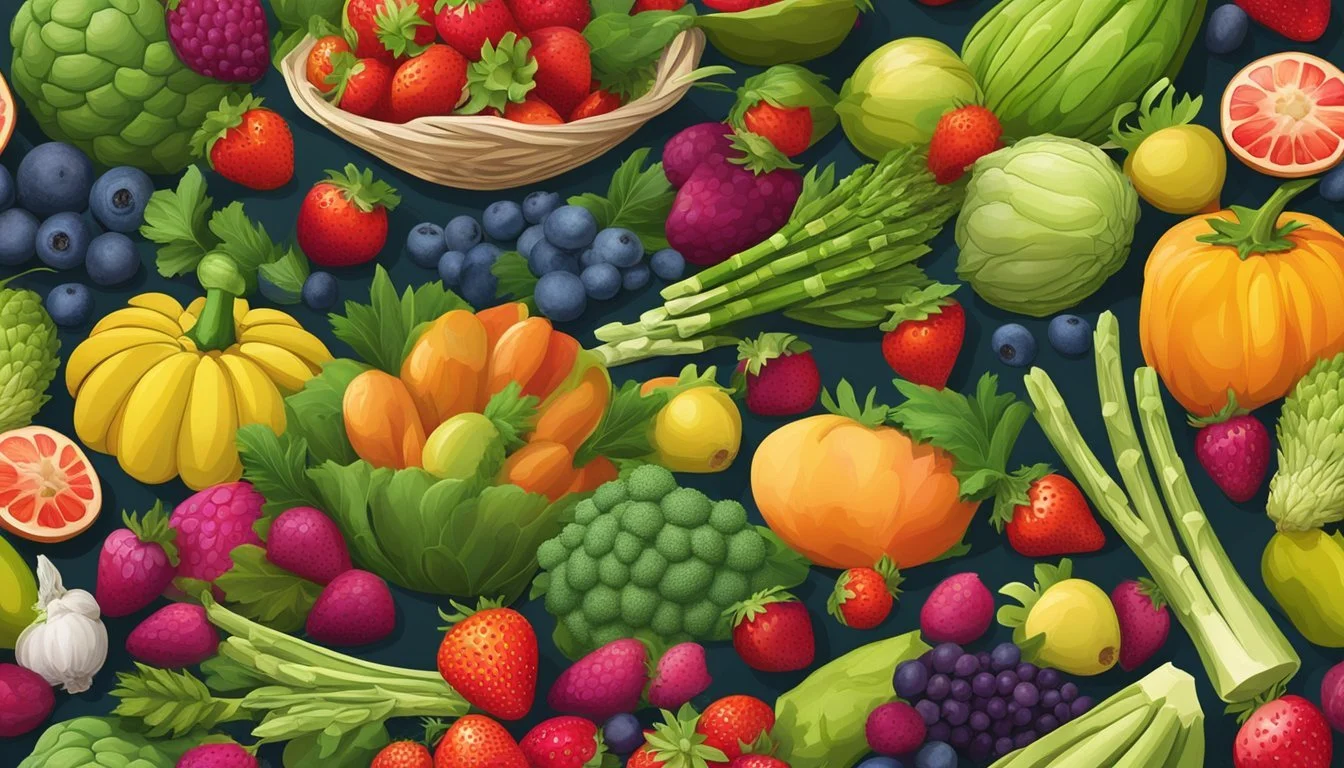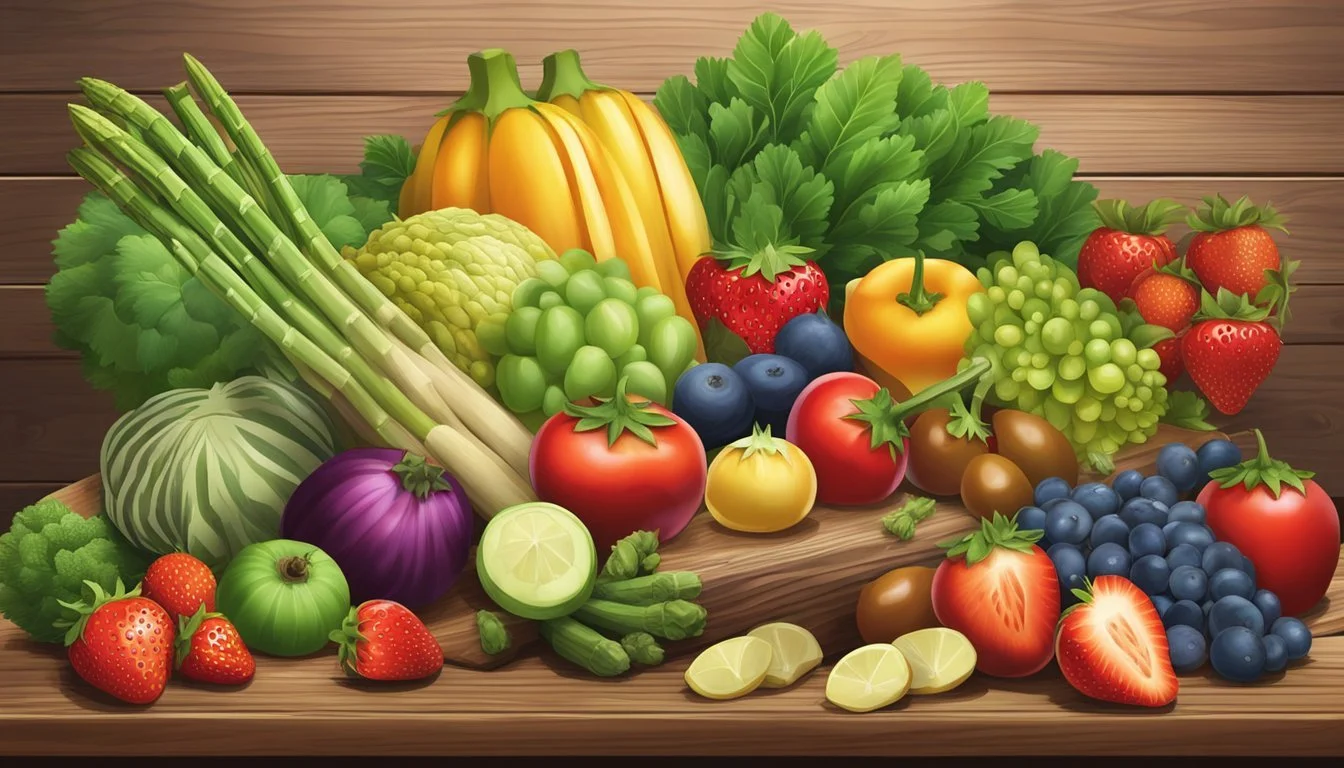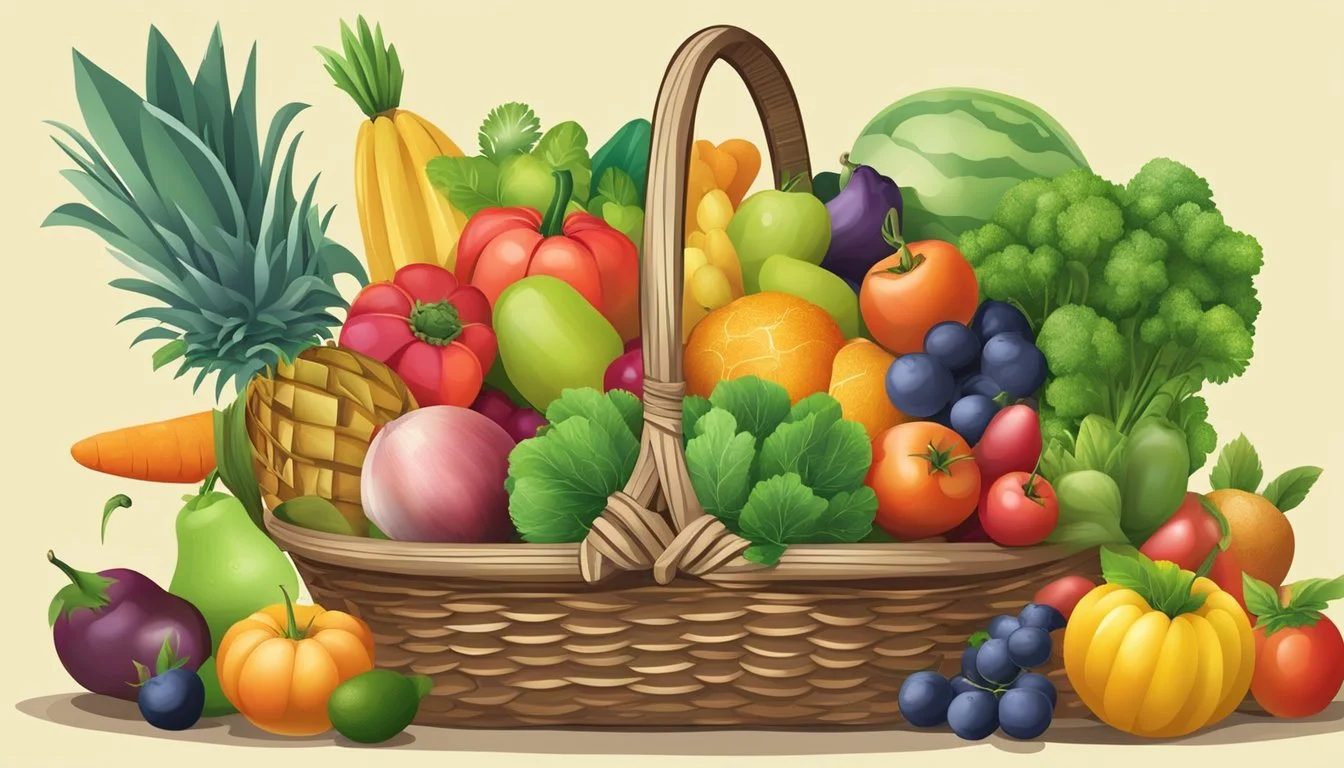Seasonal Fruit and Vegetables April
Fresh Picks for Your Diet
This Article is Part of Our Guide to Seasonal & Local Produce in the USA
April marks a refreshing transition in the produce aisles as winter's hearty offerings make way for the bright and tender fruits and vegetables of spring. Seasonal eating enthusiasts eagerly anticipate the arrival of April's produce, which is known for its peak freshness and optimal flavor. Shopping for fruits and vegetables that are in season during April not only supports local agriculture but also ensures that individuals are getting produce packed with the highest nutritional content and taste.
During this month, markets begin to burst with vibrant green vegetables; asparagus (how long does asparagus last?) and artichokes (What wine goes well with artichokes?) reach their prime, offering crisp textures and delicate flavors that are representative of spring's essence. Root vegetables such as parsnips, which have sweetened in the cool earth, continue to be available, while the appearance of fava beans (how long do fava beans last?) and pea varieties ushers in a fresh taste of the season. The trend toward eating what is in season during April aligns with a growing awareness of sustainability and a desire to enjoy produce at its most delectable stage.
The fruit selection, though more limited than the bountiful summer months, also sees a shift towards lighter options. Rhubarb emerges in April, often used to create tangy desserts that herald the warmer days ahead. Stores remain stocked with year-round staples such as avocados (how long does avocado last?) and bananas, ensuring a variety of flavors and nutrients can be enjoyed alongside seasonal specialties. In embracing April's seasonal fruits and vegetables, consumers find themselves at the intersection of culinary delight, environmental responsibility, and healthful living.
What’s in Season in April in Your State?
Texas Seasonal Fruit and Veg in April
Seasonal Overview
April marks a transition in the growing seasons, with winter produce phasing out and the bright, flavorful bounty of spring becoming available. This month's harvest offers a variety of fruits and vegetables that are not only fresh but also packed with nutrients.
April's Seasonal Produce
Vegetables: Shoppers can expect a surge of freshness in their local markets, with produce such as asparagus, artichokes, and spring onions. The crispness of snap peas and the earthy flavors of new potatoes and radishes epitomize spring's arrival. Leafy greens like spinach, arugula, and lettuce are also abundantly available, bringing a range of textures and flavors to the table.
Fruits: April's fruit selection may be less extensive than vegetables, but certain fruits like rhubarb stand out for their tart and tangy flavor, which is a harbinger of the forthcoming fruit seasons. Consumers eagerly anticipate the first strawberries of the year, which often arrive toward the end of the month.
Health Benefits of Seasonal Eating
Eating seasonally in April provides not only a palette of flavors but also a host of health benefits:
Nutrition: Seasonal fruits and vegetables tend to be at their peak in flavor and nutrient content. They provide essential vitamins and fiber, critical for maintaining good health.
Diversity: A rotating selection encourages a varied diet, important for getting a wide spectrum of nutrients throughout the year.
Freshness: April produce often requires less transportation and storage time, so it typically retains more of its natural nutrient profile when it reaches consumers' plates.
By focusing on the plants that naturally thrive in April, consumers can enjoy a diet that is not only flavorful and nutritious but also in harmony with the natural growing cycle.
Fruits in Focus
April brings a bounty of fruits into season, enriching markets with a wide selection, from tangy citrus varieties to sweet berries and tropical fruits. Consumers can savor the enhanced flavor and nutritional value of these seasonal offerings.
Adoring April's Fruits
In April, strawberries come into the limelight, offering their ripe, juicy flavor. This fruit is not only a favorite for its taste but also for its versatility in dishes ranging from breakfast cereals to elegant desserts. April is an ideal month to indulge in kiwi as well, prized for its vibrant green flesh and unique tangy taste.
Citrus Varieties
Citrus fruits such as lemons and oranges are still plentiful in April. Lemons add a fresh zing to beverages and dishes alike, while oranges provide a juicy burst of vitamin C. These citrus fruits are excellent either as standalone snacks or as components in fruit salads.
Tropical Delights
April is a perfect time for tropical fruits, with mango and pineapple being particularly notable. Mangoes, with their creamy flesh and sweet taste, are great in smoothies or as a tropical twist to salsas. Pineapples provide a juicy, refreshing treat and serve as a key ingredient in many sweet and savory dishes.
Berries and Apples
Although often associated with fall, apples maintain their crispness and variety in April. They are an ideal, portable snack and a staple for many baked goods. Berries, including the first harvest of strawberries, start to make their way into the market, signaling the onset of the berry season that extends into the summer.
Vegetables in the Limelight
As April ushers in the freshness of spring, a variety of vegetables reach their peak of flavor and nutrition. The market's bins brim with earthy roots, vibrant greens, and crunchy legumes, each adding unique qualities to the spring table.
Cruciferous Vegetables and Greens
April is prime time for cruciferous vegetables such as kale, cauliflower, and cabbage. These nutrient-dense vegetables are not only rich in vitamins but also high in fiber which supports healthy digestion. They are versatile in the kitchen and can be enjoyed raw or cooked. Lettuce, with its crisp texture, and arugula, notable for its peppery taste, make excellent bases for spring salads. Spinach, another April favorite, is both tender and nutrient-packed, perfect for salads and sautés.
Kale: Excellent in salads or chips
Cauliflower: Roast or mash for a nutritious side
Arugula: Add to salads for a peppery kick
Spinach: Saute with garlic for a quick, healthy dish
Roots and Bulbs
Root vegetables like radishes and beets offer a satisfying crunch and a burst of color. They can be served raw, pickled, or roasted to bring out their natural sweetness. Carrots, available year-round, are particularly sweet in the spring. Shallots and spring onions, with their mild flavor, are perfect for adding depth to dishes without overpowering other ingredients.
Radishes: Slice for a peppery addition to salads
Beets: Roast to enhance their earthy sweetness
Legumes and Pods
April also brings tender legumes into the spotlight. Peas, including snap peas, fava beans, and peas, each deliver a distinct sweet flavor and a pleasing snap that reflects the essence of spring. They are great when blanched and added to pasta or rice dishes, or even eaten raw in salads for a fresh, green taste.
Snap Peas: Eat raw or quickly saute for a sweet crunch
Fava Beans: Blanch and peel for a buttery addition to meals
Incorporating these April vegetables into meals not only enhances flavor but also adds nutritional value, marking the shift to lighter, springtime eating.
Culinary Inspirations
As April brings a variety of fresh produce to the forefront, chefs and home cooks are presented with an assortment of ingredients perfect for vibrant dishes. These seasonal treasures inspire a range of culinary creations, from simple, zesty salads to rich, comforting casseroles.
Simple and Fresh Recipes
A collection of fresh recipes puts the spotlight on April's bounty. For example, steamed broccoli can be elevated with a drizzle of olive oil, lemon zest (how long does lemon zest last?), and a sprinkle of chives. Incorporate sliced radishes and celery into a crisp salad for a peppery crunch. Snack on homemade muffins that capture the essence of the season with diced strawberries or minced ginger.
Strawberry Ginger Muffins
Fresh diced strawberries
Minced ginger for a warm kick
Hearty Cooked Dishes
The heartier side of April's produce can be savored in comforting cooked dishes. Roasted carrots glazed with a touch of honey and butter pair splendidly with grilled chicken. Potato leek soup with a swirl of cream represents the essence of spring while providing warmth on cooler days. One can't forget a cheesy asparagus and egg casserole that's perfect for brunches.
Potato Leek Soup
Leeks and potatoes for a creamy base
A swirl of cream for decadence
Light Salads and Seasonings
April's greens inspire light and flavorful salads. Toss peppery arugula with slivers of avocado, cherry tomatoes, and a simple vinaigrette for a quick side. Coleslaw made with fresh cabbage and bright herbs like dill or parsley offers a crunchy companion to shrimp tacos. Enhancement of these dishes is easily achieved with freshly minced garlic and aromatic olive oil.
Avocado Arugula Salad
Rich avocado slices
Tangy cherry tomatoes
Shopping and Storage Tips
When shopping for produce in April, selecting fresh items and storing them properly ensures that they maintain their flavor and nutritional value. This guide provides practical tips to help consumers make the most of April's seasonal fruits and vegetables.
Selecting the Best Produce
When choosing pineapples, one should look for fruit with a sweet fragrance at the base, indicating ripeness. The skin should be golden brown, and the leaves in the crown should be green and fresh-looking. For cabbage, compact heads that are heavy for their size are prime. They should have crisp, tightly packed leaves.
Asparagus should have firm, bright green stalks with tightly closed tips. Avocados (specifically Haas) should yield to gentle pressure without soft spots. Fresh spring onions, peas, and lettuce like romaine should appear vibrant and unwilted.
Storing for Freshness
Pineapples can be kept at room temperature for a day or two before slicing and then should be refrigerated in an airtight container. Cabbage, asparagus, and lettuce will retain freshness when stored in the crisper drawer of the refrigerator. For optimal preservation, wrap them in damp paper towels before placing them in breathable bags.
To store avocados, keep unripe ones at room temperature. Once cut, brush the exposed flesh with lemon juice and keep in an airtight container in the fridge. Peas are best kept in their pods and refrigerated in a bag. Spring onions can be stored in the fridge; their roots trimmed and placed upright in a container with water or wrapped in a damp paper towel and bagged.
Gardening and Farming Insights
April marks a dynamic transition in the gardening calendar, bridging the gap between the final frost dates of March and the onset of a typically warmer May. This period is crucial for gardeners and farmers alike as they plant seasonal produce, ensuring a bountiful harvest throughout the growing season.
Growing Your Own
With the last of winter's chill giving way to the milder breezes of spring, gardeners take advantage of April's soil revitalization to plant a variety of fruits and vegetables. They must keep soil temperature in mind, as certain seeds require a warm bed for optimal germination. The following table outlines ideal vegetables for April sowing:
Vegetable Soil Temp for Germination (°F) Carrots 45 - 85 Lettuce 40 - 80 Spinach 50 - 70 Peas 40 - 75
Gardeners should ensure that beds are well-prepared with compost or fertilizers before planting to nourish the young seedlings. Warmer days allow for the successful sowing of tomatoes and peppers indoors, getting a head start before transplanting them outdoors in May.
Supporting Local Farmers
Farmers anticipate local consumers' demand for fresh, seasonal produce by strategically planting in April. They often offer a variety of hearty greens and root vegetables, such as kale and beets, which are resilient in unpredictable spring weather. Consumers can support local agriculture by purchasing these items at farmers’ markets or through community-supported agriculture (CSA) programs. These interactions not only bolster the local economy but also reduce the carbon footprint associated with long-haul transportation.
By choosing to buy from local farmers during this season, consumers have access to the freshest produce while encouraging sustainable farming practices. It's an investment in the community's health, economy, and the environment.
Beyond the Plate
When considering the in-season produce for April, one must take into account not only the nutritional benefits but also the broader implications on environmental sustainability and cultural practices.
Environmental Impact and Sustainability
Seasonal produce in April in the US, such as asparagus, artichokes, and leafy greens, supports sustainable farming practices. During this month, these crops align with natural growing cycles, which can reduce the need for artificial heating, lighting, and excessive transportation. Utilizing a produce guide for April's in-season offerings encourages local consumption. It also diminishes the carbon footprint, as importing foods from distant locations often involves significant fuel use and emissions. Eating what's in-season can help to maintain the natural balance of the environment.
Carbon Footprint: Local April crops demand less transport, leading to lower greenhouse gas emissions.
Water Usage: Seasonally appropriate crops often require less water, contributing to conservation efforts.
Community and Cultural Significance
April's seasonal produce carries cultural significance for many communities. These fruits and vegetables herald the arrival of Spring and play a role in various seasonal festivals and community events. For example, the use of artichokes and spring onions in local cuisine is not just a culinary choice but a reflection of cultural heritage. People often gather at farmers' markets to celebrate the abundance of April's produce, strengthening community ties and reinforcing traditions based on the season's bounty.
Cultural Traditions: Many recipes using April produce are passed down through generations, keeping cultural practices alive.
Community Engagement: Local farmers' markets featuring in-season fruits and vegetables become hubs of activity, fostering social connections.
Conclusion
April marks a period where a variety of fruits and vegetables come into season, offering not only peak flavors but also optimal nutritional benefits. Consuming seasonal produce can often be more economical and environmentally friendly, as it typically requires less transportation and storage.
In this month, staple spring vegetables like asparagus and artichokes are at their best. Snap peas, young carrots, and fava beans make fresh, crunchy additions to any meal. Leeks and fennel (how long does fennel last?) provide aromatic flavors, perfect for refreshing spring dishes.
For those with a sweet tooth, April is a fine time for pineapples, rich in Vitamin C and other nutrients. One should choose pineapples with a strong sweet smell, indicative of ripeness and taste.
Here's a quick guide to simplify shopping for April's best:
Vegetables Fruits Asparagus Pineapples Artichokes Snap Peas Young Carrots Fava Beans Spring Garlic Spring Onions Leeks Fennel Radishes
Embracing seasonal produce doesn't just add freshness to one's table, but supports local agriculture and reduces one's carbon footprint. Individuals are encouraged to enjoy the diverse flavors and nutritional offerings that April's seasonal fruits and vegetables provide.







